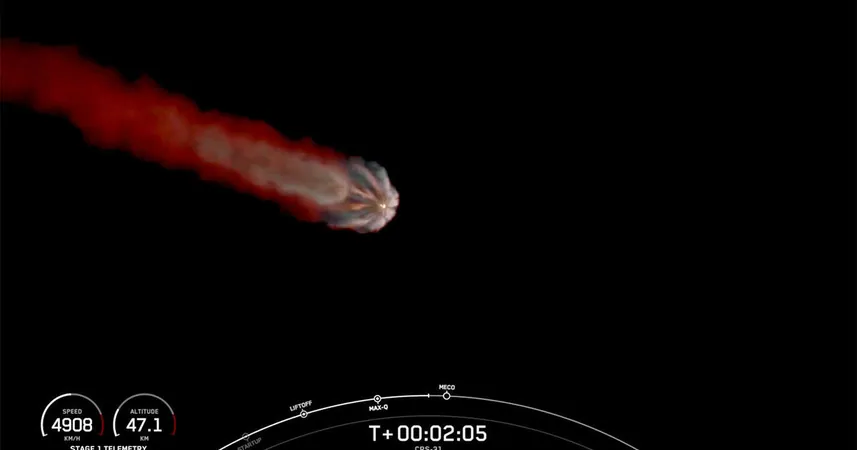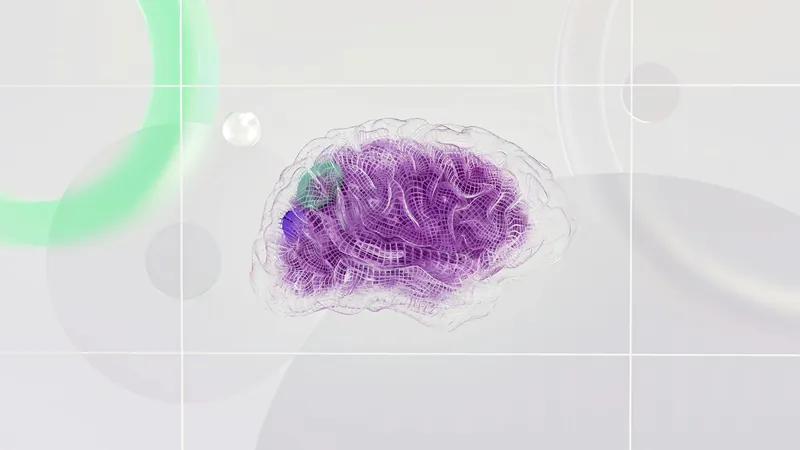
SpaceX Dragon Delivers Supplies, Unique Experiments, and Holiday Cheer to ISS!
2024-11-05
Author: Yu
Introduction
In a stunning launch on Monday evening, SpaceX sent an uncrewed Dragon cargo spacecraft soaring into the cosmos, brimming with three tons of essential crew supplies, groundbreaking scientific gear, and festive treats for the International Space Station (ISS) crew. This spectacular flight, which occurred just one day before the election, has exhilarating implications not only for astronauts but also for ongoing research in space.
Launch Details
The Dragon was propelled into orbit by a Falcon 9 rocket, which took off from the historic launch pad 39A at Kennedy Space Center at 9:29 p.m. EST. Its ascent lit up the night sky with a breathtaking display, generating 1.7 million pounds of thrust as it broke free from Earth's dense atmosphere.
Once the first stage of the rocket completed its mission, it successfully returned to Earth, landing as intended at the Cape Canaveral Space Force Station. This milestone marks SpaceX's 57th successful booster recovery at the Florida facility, contributing to an impressive total of 363 successful landings across various platforms, including both California flights and ocean droneship recoveries.
Dragon’s Journey to the ISS
Almost ten minutes post-launch, the second stage of the Falcon 9 powered off, allowing the Dragon to detach and proceed autonomously toward the ISS. If all goes according to plan, the vessel will rendezvous with the station on Tuesday morning, aiming for a docking time of 10:15 a.m. EST.
Innovative Experiments
Among the myriad supplies on board lies an ambitious test scheduled for Friday: the Cargo Dragon’s thrusters will be employed to slightly boost the station’s orbit— a first for SpaceX. This move is crucial as it diversifies the means by which the ISS can be reboosted, traditionally handled by Russian Progress freighters and Northrop Grumman’s Cygnus vessels.
Adding to the excitement, SpaceX has secured a NASA contract to develop a powerful space tug. This innovative vehicle aims to safely guide the ISS back into the Earth’s atmosphere at the end of its operational life, expected around the 2030s, ensuring that it disintegrates over uninhabited ocean regions, away from human activity.
Scientific Contributions
This latest cargo mission also features impressive scientific experiments, including the Lignosat, a small wooden satellite constructed from sustainable magnolia panels by researchers in Japan. This unique payload is part of a groundbreaking study to assess the viability of using wood in space, measuring parameters such as temperature and structural strain in the challenging conditions of outer space.
Furthermore, the Cargo Dragon’s payload includes over 6,000 pounds of provisions—2,022 pounds dedicated to scientific endeavors, alongside 2,119 pounds of crew clothing, food, and supplies. Astronauts will be delighted with their food kit that boasts a variety of fresh produce such as apples and blueberries, alongside special holiday fare like lobster, crab, and quail.
Advanced Research Instruments
Moreover, a cutting-edge instrument called the Coronal Diagnostic Experiment (CODEX) will be deployed outside the ISS to deepen our understanding of solar wind dynamics, revealing insights into how charged solar particles receive heat and gain speed, affecting both the Earth and the wider solar system.
Future Exploration
As the crew prepares for a month of innovative experiments aboard the station, they will also test plants’ resilience in outer space with ARTEMOSS, study material degradation from UV exposure, and explore essential cold welding technologies crucial for possible future repairs in space.
Conclusion
Overall, this SpaceX cargo mission not only embodies innovation and scientific exploration but also serves to enhance the lively spirit aboard the ISS with thoughtfully prepared holiday treats. What thrilling discoveries await the astronauts in the coming weeks? Stay tuned as NASA and SpaceX continue to push the frontiers of space exploration!



 Brasil (PT)
Brasil (PT)
 Canada (EN)
Canada (EN)
 Chile (ES)
Chile (ES)
 España (ES)
España (ES)
 France (FR)
France (FR)
 Hong Kong (EN)
Hong Kong (EN)
 Italia (IT)
Italia (IT)
 日本 (JA)
日本 (JA)
 Magyarország (HU)
Magyarország (HU)
 Norge (NO)
Norge (NO)
 Polska (PL)
Polska (PL)
 Schweiz (DE)
Schweiz (DE)
 Singapore (EN)
Singapore (EN)
 Sverige (SV)
Sverige (SV)
 Suomi (FI)
Suomi (FI)
 Türkiye (TR)
Türkiye (TR)